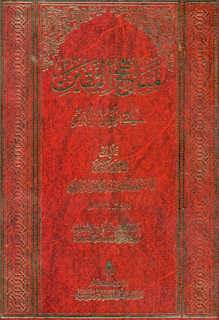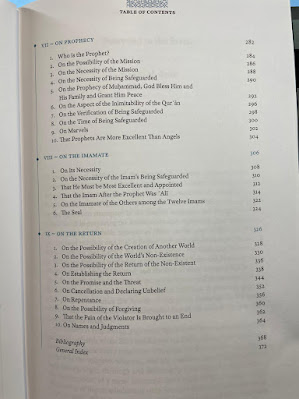Over the years, I have written a few posts about the Tajrīd al-iʿtiqād or Tajrīd al-ʿaqāʾid of the famous Imāmī philosopher-scientist-theologian Naṣīr al-Dīn al-Ṭūsī [d. 1274], which, as I discussed, became one of the major source texts (mutūn) for the discussion of theology (ʿilm al-kalām) in the late classical (for want of a better term) period in Islam. The first of this series of four blogposts is here.
The interesting question about the title is not just whether doctrines are pluralised or whether it is about the totality of (sound) belief but rather what does he intend by Tajrīd? As he himself says, the text is an exposition of the major questions of theology (taḥrīr masāʾil al-kalām) that select the unique pearls of belief (ghurar farāʾid al-iʿtiqād) Is it the pithy and rather dense form of expression that, as he himself says, is complete and eloquent? Is it that he presents a succinct (and at times seemingly incomplete) version of the arguments? And these arguments are much more than most (early) creedal works that tend to focus on the results of theological arguments and statements of belief. Anyway, this post is inspired by the fact that I am currently running a small reading group in which the text is al-Sharīf ʿAlī al-Jurjānī [d. 1413] and his ḥāshiya on the Tasdīd al-qawāʿid fī Sharḥ Tajrīd al-ʿaqāʾid of Shams al-Dīn Iṣfahānī (d. 1348, using the text established by Eșref Altaș and his colleagues and published by ISAM in Istanbul).
But here I want to discuss something else pertaining to the definition of the science or humanity of ʿilm al-kalām. This is a question of great interest these days because of the ways in which the study of kalām has become implicated in philosophy or rather Islamic philosophy, raising the fundamental question about the distinction between ḥikma and kalām. The Sharḥ al-hidāya of Maybudī [d. c. 1502] is a good place to find this (often with the gloss of Mīr Fakhr al-Dīn Sammākī [d. 1576]) as well but so are the glosses and commentaries on this opening of the Tajrīd.

Consistent with other humanities, kalām has a technical definition, a certain subject matter, certain essential properties of that subject which are investigated in that humanity, a scope, a telos, and so forth like all the other humanities did in the Islamicate contexts, extending the late antique models of how one might define a science. Ṭūsī says that ʿilm al-kalām studies matters from which one may know the nature of the afterlife (al-maʿād). As Jurjānī says in his ḥāshiya, this does not mean that he is identifying the subject matter of kalām to be the afterlife (even though that is indeed part of what is studied) since it is commonly held that the subject matter of kalām is al-mabdaʾ waʾl-maʿād, or the origins and first principles of what exists (and existence as such) and its culmination in the afterlife (and everything in between). Ṭūsī explains this by saying that in order to understand the afterlife requires a prior foundation in the study of the acts of grace and commission that God provides through the prophets and the Imams, and those commissions makes sense only if we establish the existence of God (ithbāt al-ṣāniʿ) and understand the nature of his attributes, and those issues only make sense if we have a prior understanding of the metaphysics and the language that we use to discuss such matters through Aristotelian category theory (of substances and accidents) and the general properties (umūr ʿāmma) of existence. This line of reasoning therefore renders the order of the discussion in the six chapters (maqāṣid):
- general properties of existence
- substances and accidents
- proof for the existence of God
- prophecy
- imamate
- the afterlife.
Qūshjī [d. 1474] in his Sharḥ jadīd, as it was later called, asserts that once we raise the issue of the centrality of the afterlife in kalām, then one must admit that those issues cannot be fruitfully discussed on the basis of reason alone but rather require recourse to revelation and doctrines transmitted from prophets (and Imams according to some as he puts it).

Dawānī [d. 1502] in his gloss says that of course while many details of the afterlife cannot be discerned purely by reason perhaps the one most important issue which can relates to the nature and immortality of the rational soul (nafs). In fact, Dawānī suggests that by this focus on the afterlife, Ṭūsī wants to indicates that a central, distinguishing feature of theological discourse pertains to the problem of the soul but also corporeal resurrection (al-maʿād al-jismānī) that posed a irresolvable problem for the philosophers (at least famously since Ghazālī [d. 1111] and his famous anathemisation of the philosophers on this point.
One of the most interesting commentaries on what constitutes kalām comes from the 19th century work of Shaykh Muḥammad Jaʿfar Sharīʿatmadār Astarābādī Ṭihrānī [d. 1847] entitled al-Barāhīn al-qāṭiʿa fī sharḥ Tajrīd al-ʿaqāʾid al-sāṭiʿa. This commentary is a really helpful and didactic one that sets out the issues, the arguments, the lemmata, and the positions with great clarity.

In this commentary, he considers the subject matter and the method of kalām. Sufi approaches to theology that involve some inspired experience arising from spiritual exercises that might involve modes of theurgy (al-kashf waʾl-riyāḍa) are considered but dismissed because of a language of discernment about the veracity of the claims. He opts for a definition and a method as such: the discipline of theology is one that studies the states of the first cause and principles (al-mabdaʾ) and that of the afterlife (al-maʿād) through the method of rational consideration (al-naẓar) and reflection (al-fikr). In fact, he states that the discursive element of this discipline is indicated by the fact that it is called kalām (discourse). He then quotes the definitions given by the two major authors of the late classical school-texts in kalām:
1) al-Ījī [d. 1355] in al-Mawāqif (which became popular in the commentary of al-Jurjānī and then especially the section on the general properties of existence in the gloss of Mīr Zāhid): a discipline through which one can establish (ithbāt) the doctrines of the dīn (ʿaqāʾid dīnīya) through proofs and can refute doubts (bi-īrād al-ḥujaj wa-dafʿ al-shubah). Hence it constitutes an ability or the acquisition of a critical skill. ʿAbd al-Razzāq Lāhījī [d. 1666], the son-in-law of Mullā Ṣadrā and eminent Avicennian philosopher who himself wrote an important commentary entitled Shawāriq al-ilhām, says precisely this: it is a science in the sense that one acquires a skill through the rehearsal of arguments in the field in normative terms and not whether one has to verify and ascertain the truth of every claim. However, he rejects that idea that the establishment of the doctrines is merely acquiring them and being able to rehearse them; one still has to understand them as they are in nafs al-amr (in their objective mind-independent status).

2) al-Taftazānī [d. 1390] in Sharḥ al-maqāṣid: a discipline that sets out the doctrinal principles of beliefs and of the religious dispensation (ʿaqāʾid sharʿīya wa-iʿtiqādīya) acquired from indicators that are certain (and rational); he also provides another definition: a rational art by which one may become skilled in establishing the doctrines of the dīn.
Astarābādī then sets out to consider the definition on his own terms. The first position - which he ascribes to the early mutakallimīn - is that the subject matter (whose essential properties are studied) is being qua being (al-mawjūd bi-mā huwa mawjūdun), the most general of things which is then divided through the following diairesis:
Being
Eternal [God] or
Originated - either substance or accident
Substances - Animals, minerals, or vegetables
Accidents - conditioned by life such as knowledge or unconditioned such as taste
There is here an argument about whether existence is the ultimate 'summum genera' - some of the early Muʿtazila as we know held that the thing (shayʾ) was such and the first level of the diairesis was existence and non-existence.
The second position that he cites is that of Sirāj al-Dīn al-Urmawī [d. 1283] in his well known theological manual Maṭāliʿ al-anwār, famous later in his commentary by Bayḍāwī and the gloss by Jurjānī: the subject of the discipline is the nature of God, and so one studies the positive and negative attributes of God, and his agency with respect to the cosmos such as the voluntaristic emanation of the cosmos, the origination of the cosmos, the creation of acts, the nature of the order of the cosmos and the need for prophecy, and the afterlife and other revealed matters about it. Hence to summarise: a discipline that studies the states of the creator such as his positive and negative attributes and his agency with respect to matters of the cosmos and the afterlife.

The third position is association with Shams al-Dīn Samarqandī [d. 1302], a Māturīdī theologian, in his al-Ṣaḥāʾif al-ilāhīya: a discipline that studies God's nature as it is and the nature of contingents insofar as they depend totally on God according to the dispensation of Islam. 
The fourth position that he associates with more 'recent kalām' is that it is a discipline that studies the knowable (al-maʿlūm) insofar as it relates to establishing the doctrines of the dīn. Hence it studies states of the Creator such as his oneness, his eternity and his will, and so forth, and the properties of bodies and accidents such as origination, existential indigence, composition of parts, and being mortal as per the dictates of Islam. But this is with respect to these conceptualisations and not the judgement of their existence at a particular time - thus, a normative inquiry. Lāhījī in his commentary indicates that the problem lies in the clash between philosophy and kalām in which the latter sought to attack the extrinsic (and Greek) nature of the philosophers' arguments; in the Imāmī school, as he puts it, the teaching of the Imams correspond well with the established arguments of the pillars of philosophy (the seven sages, Plato, and Aristotle of course are intended).
As is the normal order in such inquires, having established the definition, he moves onto a discussion of the benefit (fāʾida) of studying kalām (a transformation from rehearsal and imitation of doctrines to their rational understanding), the excellence (sharaf) of the discipline which is associated with the excellence of its subject matter, and finally how it might be distinguished from the principles of the dīn and of a particular school doctrine (madhhab), which for the Imāmī school lies in the five principles of divine unity, divine justice, prophecy, imamate, and the afterlife (with divine justice and imamate being the principle of the Imāmī school doctrine while the other three are true of all who adhere to Islam). Broadly this order as well as the discussion in Astarābādī follow Lāhījī but since the latter was more of a philosopher he goes into greater details on how, following Ibn Sīnā (al-Shifāʾ, K. al-burhān, II on the nature of essential accidents and so forth), one establishes the definition of a science and its subject matter and the distinction between the conceptions (taṣawwur) of the science and its assents and judgements (taṣdīq).
So what is the takeaway from this post? Reading Jurjānī's gloss is like taking a master class in philosophical theology and an intellectual challenge and pleasure. Reading Astarābādī is like reading a highly competent and quite excellent teacher who guides you through the issues at stakes and helps to locate and contextualise them well.











.jpeg)
.jpeg)


.jpeg)
.jpeg)






































